"The Gravitation Conception and Experiments" by Alexander V. Frolov

P.O.Box 37, 193024, St.-Petersburg, Russia
Tel: 7-812-2747877
Email: frolov@mail.dux.ru Documents Menu
 t
t
 h. In this case the conservation law of
energy for the "one-body closed system" can be represented as a balance of energy in the form of a mass (body) and energy
in the form of space-time (ether) around the body.
According to Newton's 1670th notion for the ether, there is not any ether in open space (space quite far from any mass) but the
ether exists only inside and near the bodies [1]. By this concept for the ether, it will be possible to develop the ether-dynamics
that will be demonstrated in this paper. The key to understanding the nature of gravitation, by Academician Vavilov, author of
the book about Sir Isaac Newton [1, p.84], is the gradient of the density of the ether in matter and empty
space.
Just the conservation law is the reason for the supposition about the chronal effect which must demonstrate itself if the system
uses a transformation of different forms of energy (mass-form and time-form) to produce the non-reactive propulsion force or
power generation. One such system is called inertia. Let us try to disclose the nature of inertia.
By the formulation proposed above, the known Newton's law describes the balance of different energy forms that demonstrates
itself as a reaction for any action. It is known that in empty space (in vacuum) any accelerating or decelerating body has some
reactive interaction with space: it is the inertia effect. So, space itself can be represented as some substance. There is
also the equality of rest mass and inertial mass that confirms this supposition.
In the paper "Optic" [1, p.86] Sir Isaac Newton stated that there is no ether in "open space". If we are considering the
mass-particle as "condensed ether", around the mass the ether is more rarefied, since it was used to create the particles, but
outside the body the density of the ether is increasing with distance from the body. In this case, the "open space" must be
considered as a very dense ether, but by Newton there is no ether in the "open space". How we can connect all this together?
Perhaps the solution is the understanding of the structure of the space, i.e. the ether can be considered as some kind of change
of the structure of the vacuum. Some local change of vacuum structure that produces the mass-particle must be compensated
by a corresponding opposite change of vacuum structure around the mass-particle. The gradient of the density of the ether is
the reason for ether flows, by Newton, and in other words it can be considered a gradient of potential and some potential field.
In this case, the notion of the "density of the ether" can be changed to the notion of the gradient of the potential "grad".
Taking that "ether" and "grad" are the same notion, we avoid the above question, since the gradient is increasing if the distance is
increasing also, but for any two points of the open space (quite far from any mass) there is not any gradient of potential. So, the
ether can not be considered as some material substance separately from space that is produced by some mass. Also note that
any matter cannot be considered separately from space. Matter is only a special structure of space or space is only different
forms of the matter and it is connected with some energy value per unit of space volume.
An important part of the gravitation concept that is proposed above, follows from M. Faraday's opinion about the nature of matter.
In his letter of June 25, 1844 to Richard Tailor, M. Faraday wrote: "So, matter anywhere is continuous... it is not necessary to
suppose the difference between atoms of the matter and some intermediate space. The forces around centres provide to these
centres the properties of the matter..."
M. Faraday considered this aspect to make a conclusion for the nature of electric conductivity and insulation. But his point of view
can be developed for the gravity aspect also. An atom and the space around the atom is the same matter in different
states. An atom or element of the atom is a local change of space structure only.
The pre-conditions above are the basis for the conclusion: Any body displaces ether mass equal to the body mass, it is a
well-known Archimede's law for ether (in generalized form). Since the motion of any body has a place inside of a real
substance, this substance (space-time itself) can be used for a "reactionless" or ether-dynamical (like aerodynamical) method
of motion. Forces are acting on the body in this case are external and the law of conservation (for energy, momentum, impulse)
is true if the body and substance around a body (air, liquid, ether) is considered a closed system.
Since ether-dynamical motion uses the mass of ether (that was demonstrated as inertial mass) to create the ether
gradient, in this case inertia effect is not produced for accelerating or decelerating objects, so: ether-dynamical
reactionless motion is inertia-less motion.
An important aspect of the gravitation concept described in this paper is the notion of paired processes of nature: gravitation
- radiation. Joseph Hasslberger described this point of view in detail ("A New Beginning for Thermodynamics", of May 8, 1993).
Two paired processes are created in Nature in strength of the energy balance, conservation law. So, if the radiation is an emission
of the photons (electromagnetic waves of any wave-length) from a mass object, the gravitation is an absorption of the photons by
mass objects.
In other words, the phenomenon of material mass as source of a gravitation field can be presented as an absorption and
transformation of electromagnetic waves. The sources of these waves are known as zero-point fluctuations. A concept of the
zero-point electromagnetic energy fluctuations which exist in empty space is published by A. Sakharov, H. Puthoff, A. Rueda,
B. Haisch [2], [3], [4], [5].
On the basis of the above let's make some proposals for experiments and consider the results of some real experiments.
h. In this case the conservation law of
energy for the "one-body closed system" can be represented as a balance of energy in the form of a mass (body) and energy
in the form of space-time (ether) around the body.
According to Newton's 1670th notion for the ether, there is not any ether in open space (space quite far from any mass) but the
ether exists only inside and near the bodies [1]. By this concept for the ether, it will be possible to develop the ether-dynamics
that will be demonstrated in this paper. The key to understanding the nature of gravitation, by Academician Vavilov, author of
the book about Sir Isaac Newton [1, p.84], is the gradient of the density of the ether in matter and empty
space.
Just the conservation law is the reason for the supposition about the chronal effect which must demonstrate itself if the system
uses a transformation of different forms of energy (mass-form and time-form) to produce the non-reactive propulsion force or
power generation. One such system is called inertia. Let us try to disclose the nature of inertia.
By the formulation proposed above, the known Newton's law describes the balance of different energy forms that demonstrates
itself as a reaction for any action. It is known that in empty space (in vacuum) any accelerating or decelerating body has some
reactive interaction with space: it is the inertia effect. So, space itself can be represented as some substance. There is
also the equality of rest mass and inertial mass that confirms this supposition.
In the paper "Optic" [1, p.86] Sir Isaac Newton stated that there is no ether in "open space". If we are considering the
mass-particle as "condensed ether", around the mass the ether is more rarefied, since it was used to create the particles, but
outside the body the density of the ether is increasing with distance from the body. In this case, the "open space" must be
considered as a very dense ether, but by Newton there is no ether in the "open space". How we can connect all this together?
Perhaps the solution is the understanding of the structure of the space, i.e. the ether can be considered as some kind of change
of the structure of the vacuum. Some local change of vacuum structure that produces the mass-particle must be compensated
by a corresponding opposite change of vacuum structure around the mass-particle. The gradient of the density of the ether is
the reason for ether flows, by Newton, and in other words it can be considered a gradient of potential and some potential field.
In this case, the notion of the "density of the ether" can be changed to the notion of the gradient of the potential "grad".
Taking that "ether" and "grad" are the same notion, we avoid the above question, since the gradient is increasing if the distance is
increasing also, but for any two points of the open space (quite far from any mass) there is not any gradient of potential. So, the
ether can not be considered as some material substance separately from space that is produced by some mass. Also note that
any matter cannot be considered separately from space. Matter is only a special structure of space or space is only different
forms of the matter and it is connected with some energy value per unit of space volume.
An important part of the gravitation concept that is proposed above, follows from M. Faraday's opinion about the nature of matter.
In his letter of June 25, 1844 to Richard Tailor, M. Faraday wrote: "So, matter anywhere is continuous... it is not necessary to
suppose the difference between atoms of the matter and some intermediate space. The forces around centres provide to these
centres the properties of the matter..."
M. Faraday considered this aspect to make a conclusion for the nature of electric conductivity and insulation. But his point of view
can be developed for the gravity aspect also. An atom and the space around the atom is the same matter in different
states. An atom or element of the atom is a local change of space structure only.
The pre-conditions above are the basis for the conclusion: Any body displaces ether mass equal to the body mass, it is a
well-known Archimede's law for ether (in generalized form). Since the motion of any body has a place inside of a real
substance, this substance (space-time itself) can be used for a "reactionless" or ether-dynamical (like aerodynamical) method
of motion. Forces are acting on the body in this case are external and the law of conservation (for energy, momentum, impulse)
is true if the body and substance around a body (air, liquid, ether) is considered a closed system.
Since ether-dynamical motion uses the mass of ether (that was demonstrated as inertial mass) to create the ether
gradient, in this case inertia effect is not produced for accelerating or decelerating objects, so: ether-dynamical
reactionless motion is inertia-less motion.
An important aspect of the gravitation concept described in this paper is the notion of paired processes of nature: gravitation
- radiation. Joseph Hasslberger described this point of view in detail ("A New Beginning for Thermodynamics", of May 8, 1993).
Two paired processes are created in Nature in strength of the energy balance, conservation law. So, if the radiation is an emission
of the photons (electromagnetic waves of any wave-length) from a mass object, the gravitation is an absorption of the photons by
mass objects.
In other words, the phenomenon of material mass as source of a gravitation field can be presented as an absorption and
transformation of electromagnetic waves. The sources of these waves are known as zero-point fluctuations. A concept of the
zero-point electromagnetic energy fluctuations which exist in empty space is published by A. Sakharov, H. Puthoff, A. Rueda,
B. Haisch [2], [3], [4], [5].
On the basis of the above let's make some proposals for experiments and consider the results of some real experiments.
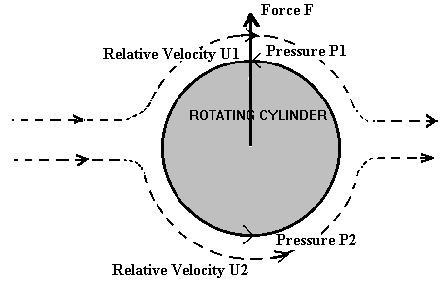
Another well-known method for the same aerodynamical effect is the Gukovsky-Chaplygin wing profile, Fig.2.
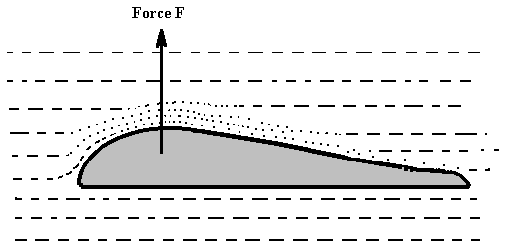
Different relative velocities U1 and U2 between the body (cylinder or wing) and space substance (air, liquid...) correspond to different pressure values P1 and P2. There is some non-compensated resulting force F that is described as a gradient of pressure. This force is not reactive and can be considered gravitation force. Now let's consider the magnetic field B1 (a constant field of some source) and a magnetic field of some moving charged mass Mq (a magnetic field of the current) B2, Fig.3.
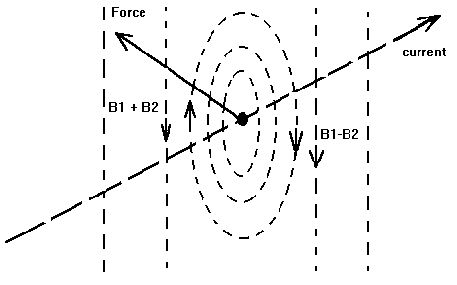
From one side of the charged moving mass M the fields are co-directed B1 + B2 but from other side they are contra-directed B1 - B2 (B1 is the external field and B2 is the field of the current). The resulting field around the charged mass M is asymmetrical. In strength of this reason the well-known Lorentz force F is the result of the gradient magnetic field i.e. different ether pressure on the moving charged mass-body. This aspect was not disclosed before since modern science doesn't recognize the ether concept. It is necessary to provide the space with properties of substance for it. In this sense the Ether concept is true and the ether gradient can be considered a gradient of space energy density or density of space itself. So, the nature of the Lentz force and Magnus aerodynamical effect are the same: self-propulsion non-reactive force is the result of the gradient of energy in space round the body. Since the energy by definition is a description of the different types of the motion, the gradient above (for the electromagnetic version also) is the result of relative velocity only. Since it leads to a gravitation type propulsion, the conclusion can be formulated: the phenomenon of gravitation and time can be described as a phenomenon of relative motion, i.e. motion relative to an absolute frame of reference. Note that this force can be created in closed systems also. Figure 2 shows that the structure of space (or structure of liquid, gas, ether and so on) is changed only in areas near the wing. So, in a big volume of space of closed systems this situation can be created also. It is clear from the thought experiment: for example, there is an aeroplane in some big box. If the aeroplane is in the rest state, the total weight of the box will include the weight of the aeroplane. But if the aeroplane is in flight (along some circumference trajectory inside of the box, for example), the weight of the box won't include the weight of aeroplane. When the aeroplane stops, the weight of the box must be increased. So, if the box is a "black box" and we can not observe the situation inside of it, the changes of box weight lead to a conservation law violation from the point of view that uses the local frame of reference (box).The Asymmetry of Electric Energy: Space has its own energy balance (mass-form and time-form) in certain volumes of space but we can change it by means of electric energy, for example. A simple example is a dielectric body motion in a potential electric field of some charged mass, Fig. 4. This experiment can be demonstrated by any charged thing (pen or comb) that attracts small paper pieces. The potential field E created by the charged mass M is the result of the potential 
gradient because the potential is decreasing as the distance from the charged body is increasing; the intensity E = - grad
. Note: It is not a special gradient field between two charged bodies; this gradient is provided by the property of space only.
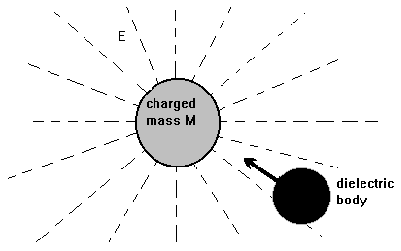
The field of charged mass M is symmetrical relative to the centre. In strength of this reason all forces to mass M are balanced and there is no propulsion force. But if the field of charged mass is asymmetrical relative to the mass itself (in strength of the special surface), the body can create some gradient and non-compensated force for itself. Another method to create a reactionless propulsion force by means of asymmetry is known as the Biefeld-Brown effect. By T.T.Brown's patent number 300,311 of 15 Nov. 1928, priority of 15 Aug. 1927, the nature of the force "X" is not disclosed by the author. This force is created in dielectrics of capacitors and it is directed toward the positive charged plate. Some explanation for this force is proposed here. Let's consider the method for non-reactive propulsion that uses centrifugal force acceleration. In the case of the circumference trajectory, force F=ma is symmetrical in (the value of force is the same in any point of the trajectory since the acceleration is the same). If the trajectory is asymmetrical and acceleration is not the same in different points of the trajectory, the force is different also. So, by closed trajectory the result force may be non-zero, i.e. some unidirectional propulsion force can be created. Figure 5 is a simple inertial drive scheme: liquid is moving by a pump inside of a curved pipe and the centrifugal force F=ma is asymmetrical, so a unidirectional force is produced.
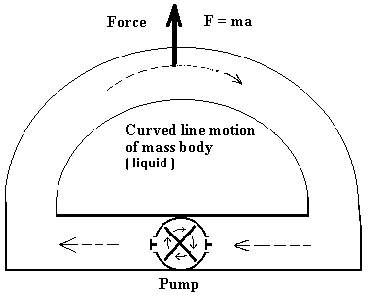
By analogy, in a capacitor, Figure 6, orbiting electrons of the dielectric are moving along a curved trajectory if an electric potential field exists between plates.
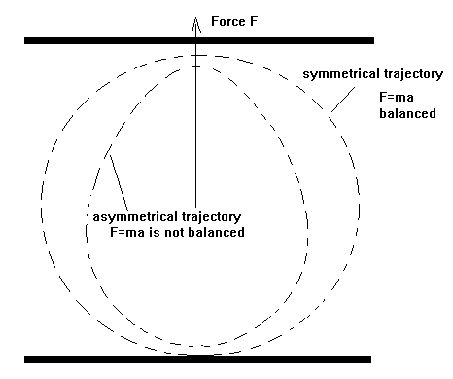
So, the nature of force "X" that was discovered in the Biefeld-Brown effect is disclosed in this paper as a curved line motion acceleration that is a result of the asymmetrical centrifugal force that is created in atoms of dielectric. The electric field of the capacitor transforms the normal trajectory of electrons into an asymmetrical one. From this point of view Brown's force "X" is an inertial phenomenon and all pre-conditions discussed in the introduction of this paper are true for Brown's electrogravitation systems. Another of Brown's patents, number 3167206, USA, 1 June 1965 is example of the asymmetry principle that allows us to use Coulomb's electrostatic forces to create a reactionless propulsion force. Figure 7 is a modified scheme of an asymmetrical capacitor that can be created for a non-reactive drive of space-craft. Lines of intensity for the electric potential field are perpendicular to the surface and in strength of this reason the action-reaction forces of Coulomb electrostatic interaction are different.
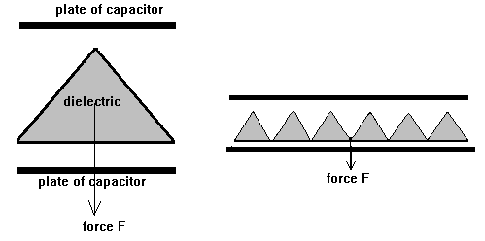
The form of dielectric surface is the reason for forces asymmetry: vector sum of all forces is not equal to zero.Asymmetry of Entropy: Another method for reactionless motion is thermogravitation - the application of thermal processes inside of some closed system to create the motion of this system. Popular Science magazine vol. 126, 1935 describes some experiment, Figure 8. Two bodies can be moving in result of repulsion from each other. One body produces impact and the other one produces impulse when bodies are reaching the ends of the rod. The result of this difference is all the device is moving in one side (where the interaction is "impulse"). 
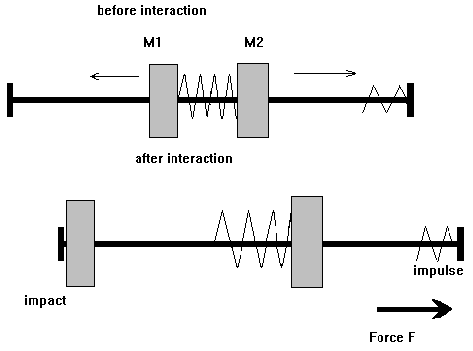
Sure, this experiment is only a non-periodical demonstration of the possibility to create asymmetry of the energy transformation. If this device must make a second act of the repulsion between two masses M1 and M2, it is necessary to return mass M1 to the centre of the device. It requires some power (force action) and the question of symmetry for net work in left and in right parts of the device is open for discussion. But the experiment is a fine example that allows us to develop the idea: Non-reactive motion of a closed system can be created as the result of asymmetrical energy transformation. Photo 9 is the author's version of the experiment that was explained in the next way: In this two-body collision there is asymmetry of the interaction.
On one side there is an elastic interaction (I used a simple rubber piece here) and the kinetic energy of the moving body is transmitted to the body of the device. In the second case the interaction is not an elastic type interaction but mainly deformation. The best version for it is an absolute solid body in this part of the device. So, on one side kinetic energy is transmitted but in the other case kinetic energy is transformed (as heat). Then, heat can be considered a chaotic motion result. So, in the second case kinetic energy is transformed in kinetic chaotic energy. So, the difference is a form of motion only: an ordered or non-ordered type of motion. If entropy notion is used for this case there is the conclusion: a gradient of entropy that is thasymmetric of energy transformations is the reason for reactionless motion. This conclusion allows us to make the proposal for some scheme, Fig.10. I am grateful to Academician V. I. Zubov, St.-Petersburg, for useful discussion on this topic.
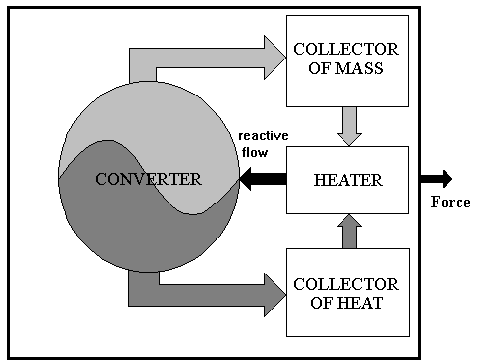
The device that uses a collector of heat, a collector of mass (water, for example), a heater that creates the reactive flow and converter that transforms heat energy of this flow in other forms of energy to return it to the collector of heat. The system can use reactive flow of mass in a closed asymmetrical cycle to create the propulsion force. This flow is flung back from the heater with some kinetic energy W=(mu2)/2 and the body of the device gets some corresponding reactive impulse. But if the velocity of steam flow is decreasing by means of heat absorption, the working mass (water) is returned to the collector of mass almost without opposite impulse since velocity of back-flow is small and kinetic energy is also small. Note, that many ancient Indian papers described flying devices that used mercury in a closed cycle to produce a propulsion force.Conclusion: Taking into consideration that the entropy function is closely connected with the direction of time flow, the asymmetry of this function in different parts of a moving system is the base for the supposition: Any "reactionless" drive produces a propulsion force in space that is paired with a time directed force. We considered above the nature of the inertia as a reaction of the ether to the acceleration or deceleration of the object. It can be linear (the value of the velocity is changing) or curve-linear (the vector of the velocity is changing) acceleration. The act of the change is an information signal that is closely connected with the phenomenon of time. Time can be considered a description of the change (motion) for some mass. It is the reaction of space to the motion of the object. This reaction is demonstrated as an inertia effect. If the motion is inertial-less, there is no information signal about it. So, non-reactive inertial-less motion must demonstrate some chronal effect also. 
Newton's Law can be generalized: By this version of known law there is some pre-conditions for new technologies: local control by rate of time by means of inertia-less motion can have unlimited velocity. The Law of conservation for quantity of the motion is true for inertia-less reaction-less systems. We can consider a new type of the motion: motion in time that is subordinated to this law also. For the mathematics it is necessary to use time directed vectors of impulse, force, electric field intensity and so on. 
References: 1. Newton I, Letter to Boile of 1679, "Isaak Newton", Acad. Vavilov S.I., published by The Academy of the Sciences of the USSR, Moscow-Leningrad, 1943, in russian, p.95-98. 2. Sakharov A., Vacuum Quantum Fluctuations in Curved Space and the Theory of Gravitation, Soviet Physics Doclady, Vol. 12, No.11, 1040-1041, 1968. 3. H.Puthoff, "Gravity as a Zero-Point-Fluctuation Force", Phys. Rew. A, 39, 2333- 2342, 1989b. 4. B.Haisch, "Zero-Point-Field-Induced Inertia and Gravitation: Questions, Answers and Issues", Department 91-30, Building 252, Lockheed Palo Alto Research Laboratory, 3251 Hanover St., Palo Alto CA 94304 USA. 5. B.Haisch, A.Rueda and H.E.Puthoff, "Beyond E=mc2", The Science, November/December 1994, Vol.34/ No.6, p.26. 
